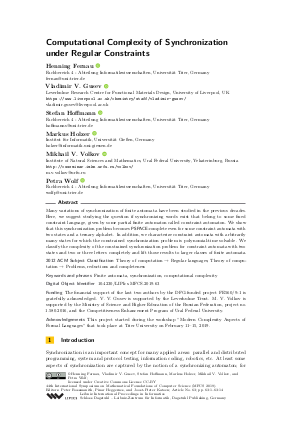LIPIcs.MFCS.2019.63.pdf
- Filesize: 0.55 MB
- 14 pages

 Creative Commons Attribution 3.0 Unported license
Creative Commons Attribution 3.0 Unported license

Many variations of synchronization of finite automata have been studied in the previous decades. Here, we suggest studying the question if synchronizing words exist that belong to some fixed constraint language, given by some partial finite automaton called constraint automaton. We show that this synchronization problem becomes PSPACE-complete even for some constraint automata with two states and a ternary alphabet. In addition, we characterize constraint automata with arbitrarily many states for which the constrained synchronization problem is polynomial-time solvable. We classify the complexity of the constrained synchronization problem for constraint automata with two states and two or three letters completely and lift those results to larger classes of finite automata.






Feedback for Dagstuhl Publishing